by Tim Clarke
(Editor’s note: I could not be happier to have this wonderful article on my site. Tim Clarke, a fine musician himself [see the Bandcamp link above or his site] has written one of the finest pieces you will find online on King Crimson’s music. Enjoy! —Allister)
In October 1978, I made a seemingly inconsequential decision. It was a decision that I had been mulling over for a month or so. The question was “Should I buy the album with the grotesque red and blue face, or not?” The album was In the Court of the Crimson King and the decision was made that much harder by the fact that I had never heard any of King Crimson’s music, and by the complete ignorance of the group’s music by radio stations and the contemporary music press at that time. None of my mates had heard King Crimson, either. I was so fascinated by the face on the cover that I was willing to take a punt on it anyway. If the music was listenable, that would be a bonus. Today, I realize that the decision I made all those years ago was hardly inconsequential. From late ’78 to mid ’79, I acquired all of the albums produced by this remarkable band, but this was merely the beginning of an adventure that has continued until the present day. I now have approximately ninety of their albums, although there is a little duplication due to the various remixing/remastering projects that have occurred during the last fifteen years. It has all been worthwhile, in my opinion.
One thing that I find unique about the music of King Crimson when compared to the other seventies prog bands that I listen to is that I don’t have a “favourite era” when it comes to KC. I find all of their music to be equally interesting, innovative and listenable, regardless of era or album, although I didn’t always feel this way. Along the way, every band will produce the odd track that doesn’t quite make the grade, for one reason or another, and KC is no exception to this, but for the last ten years or so, it doesn’t seem to matter any more. I can take the rough with the smooth. One of their albums in particular, I found very difficult to get to grips with. In fact, it took me ten years to be able to listen to it all the way through, and a further eight until I could really appreciate it. I have no definitive explanation for this, but I suspect that the problem was more to do with me than the music. No matter, it certainly made the journey much more challenging and interesting. More on that later.
King Crimson’s music appeals to me for its sheer variety. Some of it has an incredibly “angular” sound, bordering on ugliness. At other times they are capable of producing moments of extreme beauty, sometimes during the same track. The quality of the musicianship on display on their records has almost always been frighteningly good. I am fortunate enough to have seen Crimson four times (soon to be five) and can assure you that they are no slouches in a live performance situation. Their recent Live at the Orpheum mini-album (recorded on the 2014 US tour) is a testament to this.
Anyway, without further ado, let’s cut to the chase. Here are my five favorite King Crimson albums in reverse order, for dramatic effect.
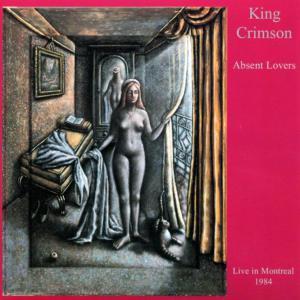 Number 5
Number 5

Absent Lovers: Live in Montreal 1984
No compilation worth its salt is complete without a live album, so here it is. If you only buy one live KC album, this should be the one. I know most of the diehard fans have probably got a suitcase full of ’em, but this is the one to pick up, regardless of which era you prefer. It features a band at the peak of its game, on what turned out to be their final live performance until the Double Trio assembled some ten years later. I’m not going to discuss all of the tracks here, but this is a fine record of the eighties Crim repertoire, and also features a couple of the old classics: “Red” and “Larks’ Tongues in Aspic (Part II)”.
Some of the performances on this album are truly stellar, and I am still amazed that a band would even attempt some of this stuff live, let alone carry it off with such aplomb. The opening improv, “Entry of the Crims”, is worth the price of admission alone, and is a good example of the evolution of Frippertronics into the nineties soundscapes (with the added bonus of the rest of the group’s contributions). “Thela Hun Ginjeet” seems to be played at slightly too fast a tempo, but the ridiculous Belew solo more than atones for this. With the opening bars of “Red”, I am reassured that sanity has returned, and it turns out to be a real corker. In his sleeve notes, Fripp tells us that he doesn’t mix “as such”. Listen to the power and intensity as the soundscape that heralds the start of “Industry” is slowly built upon and dismembered by the rest of the band as a mini-musical armageddon develops. It’s a semi-abstract piece with a jerky rhythm that possibly sounds a little out of place being played at a rock concert, but this is King Crimson, and it works. Boy, does it work. Four guys are making all this noise. It sounds like an army, and quite an angry army, too. The live KC incarnations weren’t known to take prisoners.
“Three of a Perfect Pair” is a powerful rendition of one of the great Crimbo singalongs, with its alternating 6/8 and 7/8 sections. It manages to sound both mainstream and progressive in the same pair of trousers. The bass really shines on here, propelling the track along with just the right amount of understated “wall-shake”. Brilliant. If you don’t like drum solos, don’t listen to “Indiscipline”. Speaking personally, the more I listen to them, the more I like them. I do think they’re good. Belew’s solo and the R2D2 guitar are particularly noteworthy on here.
“Sartori in Tangier” features Levin on stick, playing bass and rhythm accompaniment to Fripp’s scorching guitar-synth solo, whilst Belew has a stint on the drums, giving Bruford the opportunity to focus on his percussive paraphernalia. Check out the version of “Waiting Man“. It kicks off with a Bruford/Belew harmonized Simmons drum duet augmented by a contrasting cross-picked pattern from Fripp and a complementary figure from Levin. Belew then abandons his drums for guitar and vocals as Bruford switches to the main kit. Suddenly we’re really cooking as the drums hit and the two guitars lock onto each other in a death-dance of serpentine complexity. They are really on fire, as Belew’s comment at the end of the song quite rightly acknowledges. “Larks’ Tongues in Aspic, Part II” follows. It’s good, but I think there are better renditions available from the Double Trio era. It’s still worth a good listen or three. “Discipline” follows that and is very tight, proving once again that these guys were black belts in the art of live performance. No solos here, just four musicians working together for the common good, and it is very good indeed. “Heartbeat” slows down proceedings, giving the band a chance to take a slight breather before the final encore, “Elephant Talk”. In my opinion, there are better versions of the last pair available on other live releases from the band, but they are a good document of the live Crimson, and certainly shouldn’t be ignored. All in all, this is a very strong album, and I recommend it highly for its consistency and quality.
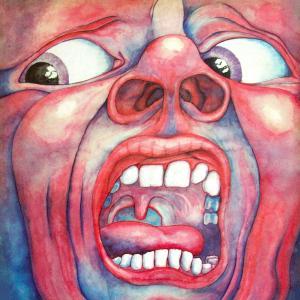 Number 4
Number 4

In the Court of the Crimson King: An Observation by King Crimson
This was the first KC album I ever bought. Imagine my surprise when “21st Century Schizoid Man” finished playing. It seemed so full of anger, attitude and energy — the ultimate protest song, but not in the regular sixties tradition. It features distorted vocals, guitar and sax riffing in perfect unison with the tightest rock rhythm section to come out of the UK in the sixties. Oh! The guitar solo. That was the daddy of them all, with its anguished tone, which sounded like it was being squeezed through an icing anointment utensil.
What a way to start a debut album. Next up is “I Talk to the Wind“, and the contrast between it and the preceding track couldn’t be more marked. A lush and polished-sounding production (particularly when compared with the earlier Giles, Giles and Fripp versions), with an air of resignation, possibly a discourse concerning the value of received wisdom, but more likely not. “Epitaph”, the first of the two “epic” pieces, follows, complete with another set of lyrics depicting a dystopian and hopeless situation, probably shaped by the tense East-West standoff that was in full swing at the time. This track featured lashings of Mellotron, but used the sound in a new and very unsettling way that certainly raised the bar in the symphonic rock stakes.
For many years, I felt that “Moonchild” was the track that didn’t “fit”. I thought that it was a piece introduced purely for its impact as a contrasting link between “Epitaph” and TCOTCK, and maybe that’s true. It wasn’t until about 1997 when I was able to listen to it as an integral part of the album. This probably coincides with my purchase of the CD, while I had previously been listening to the vinyl, along with that medium’s attendant requirement to get up and flip the record halfway through. Owning the CD allowed me the opportunity to listen to the album uninterrupted for the first time. Additionally, at about the same time, I had started to develop an interest in the Nu-ambient music prevalent in the mid-‘nineties (FSOL, Orb, etc.). Whatever the reason, I suddenly found myself able to listen to and appreciate “Moonchild” and its place within the album. It seems to have quite a light-hearted, almost playful feel, particularly during the vocal section that appears to describe the doings and activity of some mystical faerie-like creature, the lyrics being liberally peppered with verbs that describe an alternative lifestyle. The later instrumental section has a slightly “muddy” sound, perhaps suggesting darkness giving way to predawn light (alluded to in the lyrics), and featuring guitar, vibes and percussion used in an almost “jazzy” style.
This track gives the listener some welcome relief from the overbearing despair and heaviness of the previous track, before the arrival of the anthemic album closer. “The Court of the Crimson King” is another Mellotron-heavy “epic” song that features some great singing from Greg Lake, who was surely on top of his vocal game here, with backing vox from McDonald and Giles. The overall effect is very powerful, almost like a celestial choir in places. Although it’s a prog “epic”, I can almost hear evidence of a desire to “boogie” in some of the keyboard playing towards the end of the song, just before its unexpected sudden ending, which emphasizes the respite from the onslaught that has occupied the majority of the preceding forty-four minutes. I can’t overstate the impact that this album had upon me in 1978, and I can only imagine what it would have been like to have heard it in 1969. Surely this would be the hands-down winner of the all-time “Best Debut Album” award, were one to exist.
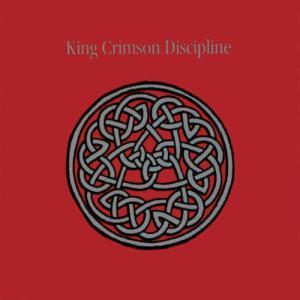 Number 3
Number 3

Discipline
In September ’81, I was browsing in a record shop and was shocked to see “King Crimson — Discipline” in the new releases section. I don’t know how I managed to miss the news that the band had reformed. A quick glance at the rear of the sleeve revealed that Adrian Belew and Tony Levin had joined Fripp and Bruford. I was already familiar with Belew. having seen him with Frank Zappa, and was also familiar with his work with David Bowie and Talking Heads. I knew Levin from his work on the first three Peter Gabriel albums, including the 1980 tour, and Fripp’s earlier solo album, Exposure. I picked up a copy of Discipline, and after talking to the sales assistant, I arrived home with the album and the knowledge that KC would be playing in London a couple of weeks later.
I rushed home to coordinate the purchase of tickets for the concert before listening to the music. I was young and impulsive like that, and it was a safe bet. The album opens with “Elephant Talk“. It was immediately apparent that this was a new chapter in the KC story. The production was more polished, and Bruford’s drum style seemed more minimal and reined-in, even compared to his recent work with UK and his own band. Levin’s Chapman Stick was a very exciting new addition to the KC sonic palette, possessing a very satisfying rumble, and the guitars meshed very well, even though they were heavily effected and/or midi-synthed.
Belew’s elephantosity seemed to sound at home within the format of this band, and the spoken vocals, taking us swiftly through twenty percent of the applicable thesaurus definitions, were a perfect fit. Belew’s guitar solo laid down a marker for the rest of the album. I found it both interesting and significant that Fripp’s guitar, whilst ever-present, was often to be found taking a back seat to his partner-in-crime. “Frame by Frame” kicks off with some breakneck guitar picking by Fripp, while Belew lays down some Stratocaster chord madness. Levin’s stick contibutions are heard and felt, presumably by Mr. Bruford, whose drums finally spring into frantic action. This was the first time Belew’s singing had been heard on a Crimson album, and I was not disappointed. He could certainly carry a tune. Levin also provides some tasty harmony vocals on here, and I found the “American” voicings and accents to be a perfect fit for the new style of music being performed by the latest incarnation of the band. Later, the polymetric signature guitar duelling for which this version of KC was renowned comes to the fore, creating some very pleasant phasing effects.
“Matte Kudasai” follows. This is a sensitive ballad, but done the KC way, with some beautiful Belew slide guitar/seagull playing whilst Fripp plays a fairly conventional backing guitar part. Levin and Bruford anchor the piece with solid but soft rhythmic backing. It is a very melodic, satisfying and rewarding track, which seems to be closely related to “North Star”, from Fripp’s 1979 solo release, Exposure.
Up next is “Indiscipline”. This is essentially a vehicle for Bruford to use the rhythm of the piece as a foil for his percussive battering and shenanigans. Belew and Fripp get to trade solos. Levin anchors the rhythm in 5/4 whilst everybody else throws significant chunks of the rulebook out the window. It is highly enjoyable and dangerous stuff. The spoken lyrics refer to a sculpture made by Belew’s wife at the time, Margaret, although for some strange reason I always imagined it to be describing Adrian’s thoughts regarding a Rubik’s Cube.
In “Thela Hun Ginjeet” Fripp and Belew’s dual-guitar intro indicates that more rhythmic disinformation is imminent, but the bassist and drummer have other ideas. Levin’s thick, solid bass and Bruford’s 4/4 groove tie the piece down with a solid foundation, whilst the rhythm guitars’ hypnotic patterns mesh with the percussive fills and riffs. Bruford’s snare gets a good workout, particularly in the later stages, and the roto-toms/octabans also take some of the limelight. The mainly spoken lyrics refer to Mr. Belew’s experiences with a gang and the police on the streets of London. “This is a dangerous place,” he says. You’d better believe it.
“The Sheltering Sky” begins as a delicate instrumental featuring Bruford playing a tongue drum. Belew’s guitar arrives with a langorous rhythm accompaniment, which is soon joined by the deep tones of Levin’s stick, a beautiful looking and sounding instrument. It’s all starting to gel very nicely, and then Fripp steams in with an acutely “angular” lead on the Roland G-808/GR-500 combo. During the center section of this track there are some particularly beautiful moments when magical harmonic sounds come to the fore.
The album closer is “Discipline“, another instrumental utilizing KC’s innovative use of interlocking time-signatures. The guitars are playing independently but together, the stick is doing its own thing in the cause of the greater good, and the drums beat a somewhat restrained groove. Halfway through the piece, the stick and the percussion call a temporary halt to proceedings before the track heads off in a groovier direction, with the percussion taking more of a front seat. This is a mesmerizing piece of music and musicianship, which, dare I say it, could be danced to? How ridiculous. Although not my favorite KC album, I think this one is their most consistent. My attention never wavers for the entire duration. There are no disappointing tracks here. It’s all good, but it’s only number 3 in my ranking. How can that be? I urge you to persevere. That which follows is nothing short of miraculous.
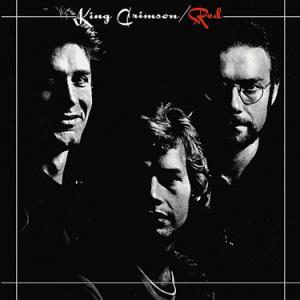 Number 2
Number 2

Red
This was a spring ’79 purchase, and one which blew me away instantly. It contains five tracks, four of them being studio creations, and one live improvisation. By the time of the album’s release, David Cross had been edged out of the band and features only on the live cut “Providence”, recorded on the penultimate date of the band’s previous tour. Guest musicians featured include Mel Collins (now playing with the 2014/2015 incarnation), Ian McDonald (whose inclusion led to widespread speculation that he would be permanently re-joining KC), Robin Miller and Marc Charig. All of these musicians had appeared on earlier KC releases.
The title track, “Red”, opens the album. Slashing, jagged power chords abound, and the rhythm section is generally having a ball with time signature changes, so smoothly executed as to be barely noticeable. This track just flies along. It’s got an angry, dangerous sound. The rear of the sleeve features a VU meter the white gradations of which run from zero to six, with seven and eight coloured red. The needle sits at 7.8. It’s easy to believe. Next is “Fallen Angel”, which features a guitar riff that had regularly appeared as part of an improvisation played at KC concerts since late ’72. The song is about a man watching his younger brother die in a fight in New York. More cheerful vibes from the KC party people. It’s the “mellowest” track on the entire album, although the ending becomes quite frantic when the guitar and cornet start their duelling, and Wetton’s bass is always there, simmering, just waiting for a chance to explode. When Fripp drops the C to A during the main riff in the last chorus, the mood, already dark, suddenly becomes more threatening. Just how I like it.
Track three is “One More Red Nightmare“. I think this marked Wetton’s debut with KC as a lyricist, and is a song about a man sleeping on a Greyhound bus, dreaming about a plane crash. It also showcases Bill Bruford’s 1974 attempt at recycling discarded cymbals. Ian McDonald is the featured soloist on alto sax. We are also treated to some enthusiastic hand-clapping, the likes of which which I can’t readily recall hearing on a prog rock album, although my memory isn’t what it used to be. There are multi-tracked guitars evident on here, and funky interludes too. Never before had Bruford’s kit had such a powerful impact as was evident on this album, the toms in particular having a weighty, full sound.
The following track, “Providence”, is a live improvisation and is the only track to feature David Cross, whose violin, with Wetton’s bass, kicks off proceedings as Bruford and Fripp wait for an opportune moment to join the fray. This one contains lots of dissonant elements, but dissonance of a highly satisfying and approachable quality. Bruford chimes in with a kick/snare/hat pattern, providing a groove that Wetton latches onto, and then Fripp starts playing his trademark high sustained lead notes before launching into a screaming solo. Cross’s violin makes a welcome return just before the end.
The final track, “Starless” seems to have a little bit of everything that is KC. At first a delicate ballad with some emotional vocals from John Wetton, it’s a song about a relationship breaking up, featuring supportive Mellotron, sympathetic percussion and bass, gentle lead guitar, and Collins and McDonald on soprano and alto saxophone respectively. The ballad continues for just over four minutes in a most reassuring but sad mood, and then the serenity of the opening is overshadowed by the introduction of one of my all-time favorite rock basslines (apparently written by Bruford). Mr. Fripp enters the fray, playing perhaps the most definitive and original guitar solo ever recorded, featuring a repeating single-note figure that must be heard to be believed. Does it work? I’ll say it does. Whilst all this is developing, Bruford starts his workout, very slowly adding to the minimal instrumentation with some well-chosen percussion, before bringing the kit drums into play. Now the piece moves into full swing, with Fripp ratcheting up the pressure, raising the pitch of his chosen note, and adding pitch-bends until the intensity of the music has again reached 7.8 on that meter. Next, the whole piece breaks down and a more frenetic version of the earlier bassline is introduced, playing a demented version of the earlier 13/8 rhythm as the saxes fire staccato notes over the top of the ramparts before eventually restating a variation of the opening theme. Another breakdown, and then all hell breaks loose before the Mellotron returns to finish the piece with a grandeur that is a fitting swan song for the seventies incarnation of the band. Unbelievable. I think the meter just reached 8.
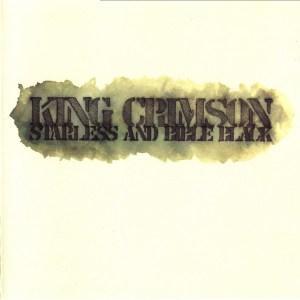 Number 1
Number 1

Starless and Bible Black
I also bought this one in the Spring of ’79. Mainly recorded live, but with the addition of a couple of studio tracks and overdubs, it kicks off at a frantic pace with “The Great Deceiver”. This track contains some of those “angular” riffs and rhythms that I alluded to earlier and effectively showcases the most powerful and malevolent rhythm section to ever appear on record. The lyrical commentary (provided by Richard Palmer-James and Fripp) seems to be decrying the morality of commercialism. Yet another in the series of powerful album-openers from KC.
The next track, “Lament” (the lyrics of which bemoan the effects/price of fame), opens in a much more sonorous and pleasant fashion with some pretty guitar and vocals. In the second verse, a delicate bass, violin and Mellotron acompaniment appears, and the song takes on an atmosphere of sweetness and harmony. It isn’t too long before the rhythm section from the dark side slowly inveigles its way into proceedings, transforming the atmosphere as it does so, until the song takes on a similar character to the previous track, but picking up a funkier groove along the way.
Having dispensed with the studio tracks, the album moves on to the first of the live recordings, beginning with “We’ll Let You Know”, a three-and-a-half minute “jam” which, if I’m not mistaken, features Bruford on vocals at 1:46! Wetton’s classy bass and Bruford’s percussion set the tone in a tantalizing build-up with Fripp’s guitar and Cross’s piano providing color and menace. The piece is building up very nicely when it comes to an abrupt stop via a fade.
The following track is a melodic, soft piece. “The Night Watch” appears to refer to Rembrandt’s painting of the same name and is an amalgamation of live and studio recordings. It features some beautiful guitar from Fripp, with some softly sung vocal lines from Wetton, and a restrained performance from the rhythm section, demonstrating their versatility and sensitivity. David Cross’s violin is also prominent on here, this being one of only two tracks where the new dark, heavy, muscular sound that the band was moving toward was absent. The second of these tracks, “Trio” is another improvisation featuring bass, viola and Mellotron. Bruford’s contribution to the piece is silence. Until hearing this, I was convinced that improvisations always had to sound edgy or dissonant. What do I know? This certainly put that misconception to bed, and then some. This is undoubtedly one of KC’s most beautiful songs, and the fact that it was caught live on tape is nothing short of miraculous.
After this, things seem to take a turn for the worse, in this humble listener’s opinion. “The Mincer” was originally a live improv that had the vocals grafted on later in the studio. The story is that the tape ran out, causing the “warbling” effect on my mid-nineties CD copy, and if I remember correctly, on the original vinyl too. So the track feels neither like a live improvisation, nor a complete “song”. It is a little disappointing, but these things occasionally happen.
For many years, side 2 was a mystery to me. I didn’t really connect with it. It used to begin playing and then my attention would wander and I would find myself concentrating on something else, losing interest in the music. It never held my attention. In the spring of 1985 I went to work overseas on a one-year contract, which eventually became an entire decade. I couldn’t take my vinyl collection with me, so I recorded my favorite (and some of my not-so favourite) tracks on cassette and shipped them ahead of me, to be listened to later. During my overseas sojourn, I suppose I lost track of the current music scene, and that, coupled with a lack of opportunity to listen to music on commercial or public radio stations, encouraged me to delve deeper into those compilation tapes. By the late eighties, I had become more receptive to “Starless and Bible Black” and “Fracture“, and by 1997 these tracks were slowly inching their way up my personal KC favourites chart. Better late than never, I suppose. “Starless and Bible Black” is a live improv, which the band seems to be at great pains to develop thoughtfully, in order to keep the piece from going off the rails. It’s not for the faint-hearted, being unremittingly dark and heavy, with Fripp playing long, sustained notes and Cross’s Mellotron holding down the fort whilst we await the rhythm section’s sledgehammer strike. This is almost certainly the best live jam I have heard Crimson (or anybody else) play. It has such a great shape and structure, sounding like a composed piece of music. This track certainly makes a great advert for atonality in a traditional “rock” format. How did they do that?
The final track is “Fracture”. This is another live track, recorded at the same concert as “Trio” and “Starless and Bible Black”, but one that the band had been rehearsing and playing live for a couple of months. It features Fripp playing some exceptionally difficult and challenging guitar motifs, even for a man of his considerable talents. David Cross again provides a foil for Fripp, with his violin, Mellotron and piano accompaniment. Underneath all of this, the rhythm section is at it again, providing a masterfully paced backing for the intricate arrangement, switching time signatures with ease and fluidity, as the music slowly increases in intensity, power and excitement, again and again. What a stunning way to end an album, even if it did take me eighteen years to appreciate it.
This has been quite a journey and is yet to achieve its final destination.
I would like to give credit to Sid Smith and his excellent biography In the Court of King Crimson, to which I had to refer to two or three times for information/confirmation. I think the book is currently out of print, but Sid is planning to release an expanded and revised version soon. If you are a serious Crimhead, this is the book for you.



